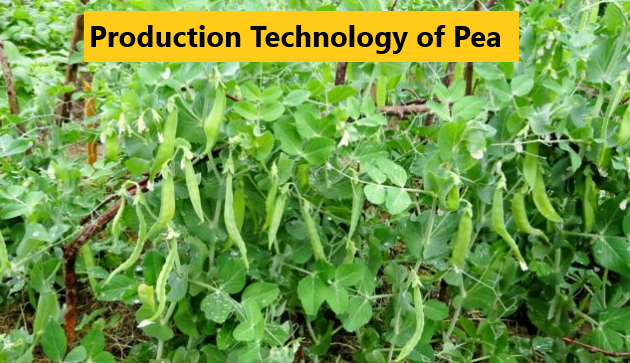How to Grow Peas/Production Technology of Pea
Botanical Name: Pisum sativum L.
Family: Leguminosae.
Importance of Pea
Pea is an important vegetable and generally cultivated for its green pods. It is highly nutritive and is rich in protein. It is used as a vegetable or in soup, canned frozen or dehydrate. It is cooked as a vegetable along or with potatoes. Split grains of pea are widely used for dal. Pea straw is a nutritious fodder.
Variety of Pea
BARI motor 1 is the high yielding variety in Bangladesh.
Early Variety: Early Bejar, Arket. Mid-season Variety: Bonevilla, Jawahar.
Climate for Pea Production
Pea is a cool season crop and performs best at 10o C to 18oC. The flower and young pods are badly affected by frost. The germination of seeds takes place at 3.3o C soil temperature. Boswell (1920) reported that as the temperature increases during the growing season the yield decline sharply. The optimum mean monthly temperature for pea is 12.8oC to 18o C.
Soil for Pea Production
Pea can be grown on a wide range of soil types, from light sandy to heavy clay. Field pea has moisture requirements similar to those of cereal grains. However, peas have lower tolerance to saline and water logged soil conditions than cereal grains. Peas will not survive long in water logged conditions. Poorly drained and saline soils should be avoided when growing field pea.
Sowing of Seed for Pea Production
Sowing Time: Generally pea sown as relay crop into Amon rice. The pea is generally sown in Rabi season from the beginning of October to mid of November. Sowing of seed during the first week of November is proper time to get higher yield.
Seed Rate: The optimum seed rate is 25 to 30 kg/ha. As relay crop, it required some more.
Method of Sowing: The pea is generally sown by broadcasting. But it may also be sown by dibbling or behind the plough. The seeds are soaked in water overnight before sowing for better germination. Seeds treated with Rhizobium culture give higher yield. Pal Sodkar et al. (1974) reported with soaking of seeds in G. A 10 ppm for 12 hour gave the highest germination and yield.
Layout and Spacing: Flatbed layout is used. Spacing is 45 X 20 cm.
Fertilizer Application for Pea Production
Fertilizer Amount (Kg/ha)
Urea 40-45
TSP 80-85
MoP 55-60
Zinc Sulphate 7-7.5
Borax 7-7.5
All fertilizer should be applied during final land preparation.
Intercultural Operation for Pea Production
Trailing and Staking: This is an important operation to be done when vines were about two month old and are at spreading stage. Generally the plants should be supported on bamboo sticks. Delay in this operation will reduce the yield considerably.
Weed Control: It is very difficult to control the weeds by mechanical methods as the crops are sown in rows in closed spacing. Uses of herbicides have been proved very such effective. Atrazine, propazine and simazine @ 0.54 kg per acre gave good broad leaf weed control. Prometryne @ 400 g per acre was most effective in improving vegetative growth and yield of pods.
Irrigation for Pea Production
Water requirement of pulse crops are higher than cereals. The water requirement of pea depends largely on Agronomic condition of the locality. The crop may be irrigated at both 10 days interval. Where rainfall is low, peas irrigation is very necessary at flowering and grain development stage.
Disease and Pest control for Pea Production
Main disease of Pea are Blights, Root Rots, Stem Rot, Powdery Mildew etc. Main Insect Pest are Pea Aphids, Lygus Bug, Grasshoppers etc. They control by taken proper management practices.
Harvesting of Pea
Maturity symptoms: Peas are harvested for table use when the pods are will fill and the young tender peas changing in colour from dark to light green.
Time: Peas may be picked in 45 to 60 days, 75 days and 100 days according to early, Mid-season and late airtimes respectively. Fresh unshielded peas may be kept 90-95% relative humidity. Mid February to Late February is harvesting time for BARI motor 1.
Yield of Pea
· BARI motor 1: 1.2 ton/ha.
· Early Variety: 25 to 40 Quintals/ha.
· Mid-Season and Late: 50 to 60 Quintals/ha
Useful Agricultural Websites
